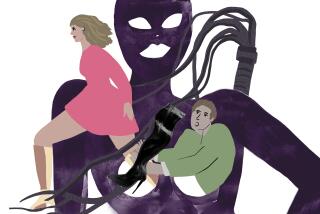Authors Chart a Course to Altar
On the eve of her 30th birthday, Monique Jellerette decided it was time to get married.
There was one hitch, however, in getting herself hitched: a man. She wasn’t in a steady relationship and, with her track record of dating only “the tall, honey-colored, light-eyed Casanovas who break all the girls’ hearts,” it didn’t appear that she’d ever make that trip down the aisle.
Around that same time, her longtime friend, Cassandra Marshall Cato-Louis, was several months’ pregnant with her second child from her second marriage. She hadn’t planned on remarrying (nor did she expect to marry the first time around, “it just happened”), but she was happy being a mother and wife. So she offered Jellerette some solid--if unsolicited--advice for her manhunt.
After suffering through a few more dates from hell, Jellerette put Cato-Louis’ advice to the test. Not only did she find a man, but she became Mrs. Robert deJongh Jr. within six months. Five years later, she’s still happily married, with two daughters.
A miracle? Not really, say the two women, co-authors of “How to Marry a Black Man: The Real Deal” (Doubleday, 1996). Part how-to manual, part journal, part workbook, the volume recounts their personal secrets of how they got to the altar, and how other African American women can too. With bold frankness and sharp wit, they argue that a good, single African American man is not hard to find. You just have to know where to look--and when to stop looking.
“What I realized from talking to Cassandra,” who’s now been married for eight years, “is that what attracted her second husband, Elmer, was that she wasn’t looking for a husband,” deJongh says. “She was busy making herself happy in all the different aspects of her life. And there’s nothing more attractive to a man than a woman who’s happy, got it together and doing her thing.”
DeJongh, a New York-based electronic designer who has worked on such television shows as “Geraldo” and “The Montel Williams Show,” found that many African American women, like herself, look for love in the wrong places and with the wrong attitude.
Through a series of self-affirmation and meditation exercises, the authors suggest that women begin reinventing and reassessing themselves in several areas:
* Spiritually (“Get in tune, Sis. A committed, serious relationship with your creator will give you the freedom to live and enjoy your life”);
* Mentally (“You need to know how to make decisions and be aware of how you make them before you can decide what you want in a man”);
* Emotionally (“You have to love yourself if you expect someone to love you”);
* Physically (“It’s your body, baby. If you don’t worship it, how do you expect someone else to?”);
* Culturally (“The truth shall set you free. Having a strong identification with your roots will empower you”).
“We’re trying to get away from superficial things,” says Cato-Louis, a Boston-based poet and actress. “We make the suggestion in the book that you have to discriminate between your wants and your needs.
“The wants come from external forces, such as media, family and society. Your needs come from your internal place. So your family may say you need a man that’s makin’ 40 grand, that has a certain kind of car, that’s livin’ in a certain kind of neighborhood, whereas your need is for someone who’s gonna come home from work every day. You may need someone who loves children and wants to change diapers in the middle of the night. . . .
“And don’t limit yourself. Go out with anybody who doesn’t make you sick.”
The authors have found that the major concern among educated and economically mobile African American women is that their intended mate bring an equal or higher standard of financial security to the relationship. That may be unrealistic, deJongh says. “Black women, struggling in this society that is racist, have a slight edge over black men. And therefore black women are saying to our men, ‘We’ve made it this far, why can’t you?’ And what we’re saying is, reevaluate that position. Black men are picking up on that attitude and it’s not attractive.”
“The fact of the matter is, there are not that many black male executives,” Cato-Louis chimes in. “Black women should look at the garbage man, the bus driver or the taxi driver--the guy who has the honest job. There are black men who are honest, decent, single and hard-working who want to be in relationships.
“Yet black women always say, ‘Oh, I want the guy to have this and that and the other thing.’ . . . We need to go back to the old-fashioned value of finding a mate and working together to get all the material things you want to get. [But first,] you want companionship, so go for companionship.”
*
Realizing that the most effective way to understand the needs of black men is to go to the source, the authors conducted numerous interviews with African American men, ages 25-70, from around the country. The responses appear as “Word From the Brothahs.” What makes an ideal mate? For one respondent, it’s when “her concept of marriage is the same as mine and [that] involves honesty, trust and dedication.”
Sounds simple enough. Yet the complexities of the African American dating game have become fodder for Hollywood. The success of “Waiting to Exhale” prompted a studio bidding war for “How to Marry a Black Man” months prior to its publication. Whitney Houston’s newly formed Touchstone Pictures-based Houston Productions won the screen rights for an undisclosed price.
“Producers are telling us that ‘Waiting To Exhale’ raised the questions and ‘How to Marry a Black Man’ gives the answers,” Cato-Louis says.
The two authors contend that they have found the perfect guide to lead women through the maze toward matrimony. Furthermore, they advise, “If he hasn’t agreed to marry you after two years, dump him”--and start again at Page 1.
(BEGIN TEXT OF INFOBOX / INFOGRAPHIC)
Ten Tips
1. Get your act together, so when you finally do meet Mr. Right, he can’t resist you.
2. Smile and say hello to every black man you see.
3. Forgive old lovers and make peace with them.
4. Tell everyone you know that you’re looking for a husband.
5. Go on as many blind dates as possible.
6. Date men who are not your “type”--you may be pleasantly surprised.
7. If you ask a man a series of questions within the first five minutes of meeting him, he’ll tell you almost anything you want to know. After that he clams up and won’t tell you a thing.
8. If you realize right away that he is someone you don’t like but he has an interesting job or hobby, he may have a friend who’s perfect for you.
9. If he’s available and you like him, don’t hesitate to let him know.
10. Dress conservatively. If you attract him with your body, how are you going to keep him with your mind?
From “How to Marry a Black Man” by Monique Jellerette deJongh and Cassandra Marshall Cato-Louis (Doubleday, 1996)
More to Read
Sign up for our Book Club newsletter
Get the latest news, events and more from the Los Angeles Times Book Club, and help us get L.A. reading and talking.
You may occasionally receive promotional content from the Los Angeles Times.






